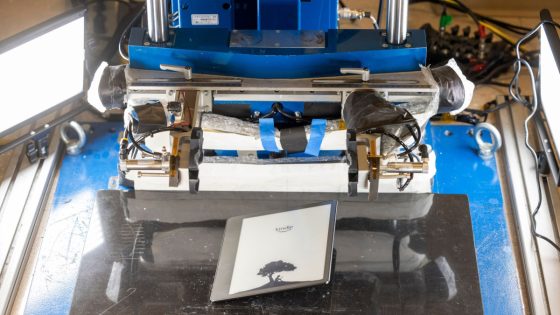Last week an article was posted on the About Amazon website written by one of Amazon’s hardware engineers that works at Lab126 and does stress tests on new products, including Kindles, and she describes 10 different ways Kindles are tested before a new device gets released, and it’s an interesting read (there are pictures of the stress tests as well).
Apparently they run dozens of different tests on Kindle prototypes to make sure they’re going to hold up to all the different things customers will potentially do to them. It makes you wonder if other ereader companies put this much effort into testing their products before releasing them into the wild.
One thing about Kindles is they do seem well made and built to last (except the cheap the entry-level models). People are still using Kindles from 10+ years ago (myself included; the Kindle Voyage is still great) so the stress testers appear to be doing a good job. Kindles do break, but considering how fragile E Ink screens are, they do seem to hold up better than some other brands.
They do different drop tests and tumble tests where they basically stick Kindles into a larger dryer-like machine to test the durability when dropped from different angles. I think these type of tests are the reason why the Kindle Scribe has a slight gap between the screen and the metal frame so the screen won’t be directly impacted from drops.
They also do backpack tests to see if Kindles can hold up when being placed in a bag with other items. This is one of the more common ways you hear of E Ink devices getting broken, especially ones with larger screens.
One of the other tests involves testing common household materials like sunscreens and lotions and even food condiments to see how they affect the external surface materials. They also do UV tests to see how Kindles will hold up when exposed to direct sunlight over time.
There’s this one picture of a Kindle in what appears to be a pressure cooker where they do waterproofing tests. They even test them in bubble baths to see how they’ll hold up.
One of the tests that doesn’t make sense to me is the four-point bend test to see how much pressure can be applied to the glass layer before it breaks. There’s a gif showing what looks like a front layer for the Kindle Paperwhite shattering during the test, but the Paperwhite is known for having a plastic front layer so I don’t see how it would shatter like that. Is the next new Paperwhite going to have a glass front layer instead?
It’s been almost two years since Amazon last released a new Kindle so hopefully they’re doing some of these tests on new Kindles right now.
via: About Amazon


I have been using Kindles and Fire Tablets from the beginning and while they do die at some point I haven’t broken a screen or broken a case. I have carried them in my pocket, my backpacks, clothes bags, Paper bags. And just throwing them on the table, car seats etc. I have even set on my PW.
The only Kindles I’ve had that broke were the entry-level Kindles.
Though how they broke was baffling, when one of them was inside a case in my purse at the time. It was also used–I think it was the Kindle 4, so that might’ve had something to do with it.
I’m still haunted about when I dropped my laptop power plug onto my plastic screen Onyx Boox. The screen didn’t break which is a plus of the plastic but there’s an annoying very visible dent on the top left corner.
I wish they’d put this much effort into updating their outdated software to include more customizable options such as more font sizes, more margins, and more line spacing. Oh and more font boldness options.
They should find a way to break Kindles so they won’t download books, or so they don’t display cover art. Oh wait, Kindles are already broken that way. They should start a new lab to fix those issues.